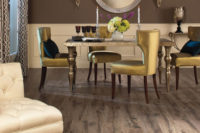Resilient Market Trends Study: Resilient Flooring Segment Picking Up Steam

Mannington Commercial’s Progressions vct
Our 2011 NFT Resilient Market Trends Study found that more retailers/dealers are finding the resilient category profitable. Forty-nine percent of the 134 respondents said that resilient flooring remains profitable (up 16% from 2010); 32% said conditions were about the same (compared to 40% in 2010). Only 19% said the segment seems to be less profitable (compared to 27% in 2010).
According to respondents, carpet leads the pack with 37% of total sales, followed by resilient (16%), ceramic tile (14%), wood (13%), laminate (11%), area rugs (5%) and stone (5%). Carpet also takes up 40% of the most total floor space in showrooms trailed by resilient (14%), ceramic tile (13%), wood (12%), laminate (11%), area rugs (6%) and stone (6%). (Chart 1.)

Armstrong’s Duality collection
The average resilient sales generated each month dipped slightly compared to 2010. Last year, 15 sales were generated a month; this year respondents have tallied 12 sales a month. However, average ticket prices for resilient flooring have increased. The mean for 2011 is $1,834, a slight rise from the $1,798 in 2010. The annual sales volume for the category has also risen to $288,774 this year compared to $246,025 in 2010.

FreeFit lvt in Pioneer Oak installed at the Solivita Active Retirement Community, Poinciana, Fla.
In 2010, resilient sheet posted the higher sales (32%), while fiberglass reinforced vinyl only represented 20% of total sales. (Chart 2.)
In all, 49% of respondents believe that 2011 resilient flooring sales will increase; 38% think it will remain the same and 13% predict a decrease. Top reasons for an expected increase included: Economy, increase in building, lower sales in other segments, cost-effective, more popular among consumers, new products, consumer confidence, and good quality. Reasons for a decrease included: Consumers want different flooring types, economy, business is down, and prices.

Seventeen percent of respondents always recommend resilient flooring to their customers, a significant decrease compared to 23 percent in 2010. Fifty-seven percent said they recommend it often (compared to 56% in 2010); 25% said they recommend it sometimes (compared to 20% in 2010). Only 1% of respondents said they never recommend resilient flooring, the same percentage as last year.


Armstrong and Mannington are the top-selling brands of resilient flooring this year, cited by 28% and 27% of respondents respectively. (Chart 3.) Top-selling fiberglass resilient vinyl flooring brands include: IVC/Flexitec/Earthscape (23%), Armstrong (22%), Mannington (15%) and Tarkett/Nafco (13%).
While there is no top-selling luxury vinyl tile brand, one-in-five respondents indicate Armstrong and Mannington as their top selling brand. The top-selling rubber flooring brand is Johnsonite (37%) followed by Roppe (20%).
Looking for a reprint of this article?
From high-res PDFs to custom plaques, order your copy today!







